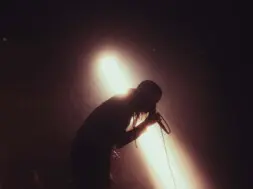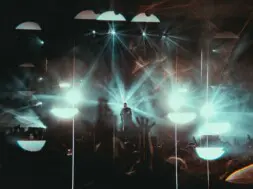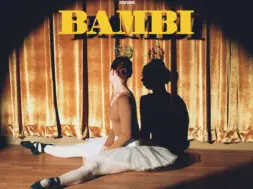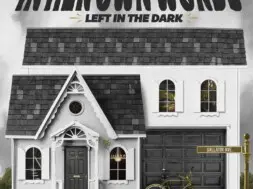
The most noteworthy point that can be made about I See Stars is that they have always seeked to change the way music as a whole is looked at. In an age where genre splicing is as common as explosions in a Michael Bay movie, the I See Stars boys have used trends and modern movements to their advantage, most notably in creating the EHM (Electronic Hardcore Music) brand.
Now with five albums under their belt, the Michigan natives are embracing change. The latest record, Treehouse, picks up where 2013’s New Demons left off. The change comes in the form of a significant lineup shift that is taking the band from being dual-fronted to a more challenging focus on singer Devin Oliver and has prompted a persistent march forward. The two members ousted include screamer Zach Johnson and guitarist Jimmy Gregerson. The most immediate question that comes to any longtime I See Stars fan is how will the band operate without a screamer to accent the heavier portions of the music?
This question was answered in the three singles that were released prior to the album’s drop date – “Mobbin’ Out”, “Break”, and “Running With Scissors”. All three tracks are indicative of the overall experience that Treehouse delivers. Indeed, for what it’s worth, Treehouse is a consistent record, perhaps even the most consistent I See Stars record to-date. With a new record however, came a new approach to the recording process. Treehouse is the first album to be recorded without Cameron Mizell or Joey Sturgis’ help. Instead, Erik Ron was called upon for production duties along with several additional producers to help with the electronic portions. The change paid off. As a result, Treehouse is the biggest and most mature sounding representation of I See Stars to-date.
The most important aspects of I See Stars’ sound are all present; continuing the EHM movement in a familiar yet totally refreshing way. Heaviness is still a pivotal piece of the band’s whole. This time around appearing in the form of a rhythm section that is inspired more by prog and djent than it is by post-hardcore and pop-punk. A key ingredient to this direction is the surprise inclusion of Luke Holland on drums. Once he is factored in, the path taken is a no-brainer. To speak of strictly instrumental heaviness doesn’t do this record its justice, however. Going back to the lineup shift and time lapse between records, it’s clear that the band have done a fair bit of struggling in the three years they’ve been relatively quiet. This built-up tension makes for a moodier and more cathartic I See Stars than ever heard before. It’s also safe to say that such a shift in focus gives this group of songs more credibility than the breakdown-laden post-hardcore of the past, allowing the listener to really latch onto the messages of betrayal and heartache portrayed throughout the record.
The entirety of Treehouse is wrapped in a certain atmospheric blanket. In exchange for melody, most of the songs put a focus on peaceful ambience, substantial electronics and Devin Oliver’s emotive vocals. In the spirit of electronic music, the songs build up and then drop before building back up again, though the songs follow the standard pop formula albeit with unique twists due to the electronic portions. Needless to say, there are hooks aplenty. As for the electronics themselves they cover a wide gamut of styles. Dubstep and R&B (“Mobbin’ Out”) to contemporary reggae-infused hip-hop (“All In”) and House (“Walking On Gravestones”) there have never been such a variety of styles in I See Stars’ music before.
“Calm Snow” opens the record with a beautiful ambience that recalls the tranquility the sight of watching falling snow can bring. It speeds up to a more beat-driven sound before rising into a hugely infectious chorus the likes of which Devin Oliver has been hinting at his whole career. The pinnacle of the song is the bridge though, where Jeff Valentine and Brent Allen’s djenty grooves pave the way for Devin to unleash a rage-fuelled shriek that even the likes of Zach never quite showed. Devin inhabits a throaty mid-range roar that brings to mind Zach’s earlier style. What the screams lack in range they make up for in timing, impact and genuine emotion. The screams aren’t just there for role call. They arguably have never been better utilized. Fast-forwarding to the fourth track on the record, “Running With Scissors” especially shows this off by accenting an especially tense build-up with the type of powerful climax it deserves. Satisfying moments like these give Treehouse major replay value.
Contrast plays a huge role in the album as well. Mainstream electronics combined with djenty polyrhythms and alternative rock choruses is a pretty unique combination and something I See Stars couldn’t have pulled off nearly as well without being this far into their career. In the same song, you’ll often hear a poppy hook that belongs in the top 40 countdown and a crushing djent-inspired riff. This exact formula is best displayed in album highlight “Light In The Cave” which has such a brilliant blend of ideas it could stand as one of ISS’ greatest musical accomplishments. “White Lies” is a solemn, but unique moment with a towering chorus that takes its time in climbing but certainly gets to the top. “Break” is no slouch either, opting to vie for one of the band’s best and most accessible career singles. The cryptic title track is certainly solid as well, but opts for more atmosphere than most of the tracks. “Two-Hearted” is the most fun and upbeat moment of Treehouse, revolving around a bouncy rhythm section and illuminated chorus. “All In” is a welcome curveball that has Devin rapping with his best Jamaican accent complete with a riotous hook and one of the record’s most memorable choruses. For any I See Stars fan wishing for a nostalgic moment, “Portals” grants such a wish through its focus on screams and “Yellow King” even recalls 3-D‘s pop rock flavors.
The best description with which to depict Treehouse as an experience is listening to a collaboration between Volumes, Paramore and Zedd – ambitious, crazy and catchier than it has any right to be. The primary focus on persistence and evolution makes for a positive and inspirational listening experience. Hearing Devin fulfill the vocals duties of two men and Andrew shift from drums to keyboard duties are all welcome changes when they are pulled off as well as they are here. Most importantly, after ten years of being a band I See Stars are finally defining the EHM concept properly and making the diverse, dynamic record they always showed the promise of creating. Treehouse is absolutely the band’s crowning achievement and one of 2016’s most infectious records.














